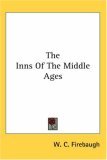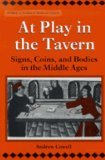|
This list covers illustrations of taverns and similar drinking establishments. (A page on 18th century inns and taverns is available elsewhere on this website.)
In these illustrations, notice the various types of signs, and the display of the garland and ale-stake. This display also comes up in several period descriptions:
-
A tauerner settes owt a wyne garlond to draw men to is taveron.
(A sermon, British Library Royal 18.B.23, c. 1450/1415)
- Avale þe stake, Avale, here ys good Ale I-fovnde!
("Tappster fyll another ale," Bodleian Arch. Selden. B.26, c. 1450)
- The grene bussh that hangeth out / Ys a sygne … / Outward, folkys for to telle / That with-Inne ys wyn to sell; / And for al that … wyn ys ther noon.
(Pilgrimage of the Life of Man, British Library Cotton Vitellius C.13), c. 1475/1430
ILLUSTRATIONS
They laugh and daunce, trippe and synge, And ley not up for her lyvynge, But in the taverne all dispendith The wynnyng that God hem sendith. Thanne goth he, fardeles for to ber With as good chere as he dide er. To swynke and traveile he not feynith, For for to robben he disdeynith. But right anoon aftir his swynk He goth to taverne for to drynk. The Romaunt of the Rose, Part B, ll. 5679-5688 - Abû Zayd at the tavern of Anah, Maqâmât (BNF Arabe 5847, fol. 33), 1236-1237
- Abû Zayd at the tavern of Anah, Maqâmât (BNF Arabe 3929, fol. 34v), c. 1240
- Dice-games in a tavern, Apocalypse (BNF Fr. 13096, fol. 51), late 13th century
- Personification of drunkeness, playing dice at a tavern, Li Tornoiemens Antecrist (Douce 308, fol. 259r), 1st quarter of the 14th century
- The Romance of Alexander (Bodl. 264), 1338-1344, fols. 158v and 204r
- The fair at Lendit, Pontifical of Sens (BNF Latin 962, fol. 264), 14th century
- White wine, Tacuinum Sanitatis (ÖNB Codex Vindobonensis, series nova 2644, fol. 87v), c. 1370-1400
- Gluttony: men drink as a cellarer passes them a drink, Treatise on the Vices (British Library Add. 27695, fol. 14), late 14th century
- Marketplace, Le Chevalier errant (BNF Fr. 12559, fol. 167), c. 1400-1405
- Red wine (fol. 84v; also here), red wine (fol. 85; also here), and wine (fol. 85v), Tacuinum Sanitatis (BNF Latin 9333), 15th century
- An innkeeper receives guests (fol. 268v) and the innkeeper in Toulouse puts a silver cup in a guest’s travel-bag (fol. 275), Schachzabelbuch (WLB Cod. poet. 2, fol. 268v), 1467
- Tale #30 from Les Cent nouvelles nouvelles, aka the Decameron (Glasgow MSHunter 252, U.4.10, fol. 70r), c. 1475-1500
- Innkeepers in the Mendel Hausbuch:
Jorg Starcz (1470),
Hans Starck (1576),
Jorg Semler (1580)
- Tavern scene (or a brothel?) by the Brunswick Monogrammist, c. 1535-1540; see also Bordello scene and Itinerant Entertainers in a Brothel
- An innkeeper, The Landauer Hausbuch, c. 1570
- Ya'qûb in a tavern, Madjâles al-'ochhâq (BNF Suppl. Persan 776, fol. 322r), 1575
- The Calling of St. Matthew by Caravaggio, c. 1599-1600
- Flemish festival, 16th-17th century
- The Kermesse of St. George by Pieter Brueghel the Younger, and this version from 1628
- Peasants Merrymaking Outside a Tavern "The Swan" by Pieter Brueghel the Younger
- Peasants at a Roadside Inn and Auberge Saint-Michel by Pieter Bruegel
MEDIEVAL INNS & TAVERNS
Obviously, many of these have been remodeled or changed over the centuries. (My intention with this set of links is to point out those which appear to be reasonably close to how they might have looked when originally built, or discussions of how they might have looked when new.)
This list covers both inns and taverns. In the modern day, we don't always make the distinction -- but an inn (or "hostrie," another fine Middle English word) would offer lodging in addition to food and drink; a tavern (or brewhouse) would likely not offer lodging. Most of the illustrations above, I think, were taverns, rather than inns; but the list below includes lodging-places.
- Gasthaus zur Waage (the Inn of the Balance); Korbach, Germany; 14th century
- Gasthaus "Zum Fürsteneck" (The Inn at the Prince's Corner); Frankfurt, Germany; 14th century
- Zum weißen Schwan (The White Swan); Neustadt an der Orla, Germany; 1384?
- The Bull, Canterbury, Kent, England; 15th century
- Brauner Hirsch (The Brown Deer); Braunschweig, Germany; 15th century
- Zum goldenen Schwan / Zum weißen Kreuz (The Golden Swan / The White Cross); Erfurt, Germany; 15th century and 1569
- An inn in Marburg, Germany; 1418/1578
- Haus Stickingen; Bacharach, Germany; 1420
- Haus zur vorderen Haue; Konstanz, Germany; 1428
|




